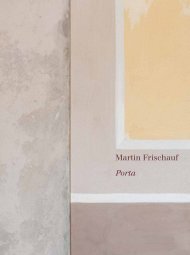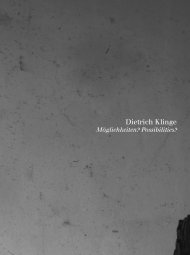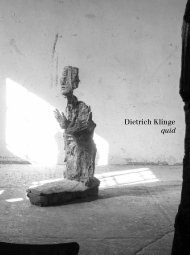Katalog_Schwerkraft_Fliehkraft
Sie wollen auch ein ePaper? Erhöhen Sie die Reichweite Ihrer Titel.
YUMPU macht aus Druck-PDFs automatisch weboptimierte ePaper, die Google liebt.
Andrea Brandl
“Schwerkraft – Fliehkraft” at Kunsthalle Schweinfurt
6
1
Klaus Gallwitz, in: Absolut
Kaspar. Hartwig Ebersbach,
Städtisches Kunstmuseum
Spendhaus Reutlingen 2006, S. 9.
Schwerkraft – Fliehkraft in der Kunsthalle Schweinfurt
Die im Mai 2009 eröffnete Kunsthalle Schweinfurt
im ehemaligen Ernst-Sachs-Bad hat sich mit ihrem
Schwerpunkt, Facetten deutscher Kunst nach 1945
zu zeigen, inzwischen in der Museumslandschaft in
Deutschland positionieren können. Das 10-jährige
Jubiläum wurde nun zum Anlass genommen,
eine Neukonzeption des Hauses zu realisieren,
die vor allem die Erwerbungen der vergangenen
Dekade im Bereich Skulptur, Malerei, Videokunst,
Fotografie oder Mixed Media in den Fokus rückt.
Völlig neu ist die Präsentation der ständigen
Sammlung im gesamten Untergeschoss mit seiner
wunderbaren Lichtfülle und den hohen weißen
Wänden, auf denen sich besonders große Formate
frei entfalten können. Der Fokus richtet sich dort
auf das Thema „Individuum und Gesellschaft“
und bietet gesellschaftspolitische Themen ab den
1950er Jahren an, die Deutschland seit der Teilung
in zwei deutsche Staaten prägten. Folgerichtig
spielt auch der Ost-West-Dialog um den Mauerfall
bzw. das Wendejahr 1989/90 eine entscheidende
Rolle, die Neuhängung bildet Akzente zu diesen
zentralen Fragestellungen bis heute aus. Ganz
Blick in die ständige Sammlung im Untergeschoss der Kunsthalle
bewusst wird die Aufmerksamkeit auf solche
Künstler gelenkt, die in der DDR geboren wurden
und bislang in deutschen Sammlungen – mit
Ausnahme einiger weniger – noch nicht wirklich
angekommen sind. Der Betrachter wird erstaunliche
Parallelen entdecken: Die Sichtweisen der Künstler
aus dem getrennten und wiedervereinten Ost- und
Westdeutschland sind ähnlicher als vielleicht
vermutet!
Im Herbst 2019 jährt sich der Fall der Mauer.
Nach einer vielbeachteten Ausstellung mit
verschiedensten Künstlerpositionen aus Ost
und West bereits im Jahr der Eröffnung zeigt die
Kunsthalle Schweinfurt jetzt mit dem in Leipzig
lebenden Hartwig Ebersbach (geb. 1940 in
Zwickau) und Dietrich Klinge aus Heiligenstadt
im Eichsfeld (geb. 1954), der seinen Wohnsitz
im mittelfränkischen Weidelbach hat, zwei
herausragende Künstlerpersönlichkeiten aus der
ehemaligen DDR. Dass sich weitere Institutionen
in Schweinfurt, wie die Evangelische Kirche
St. Johannis und die Sparkassengalerie, an dem
Projekt beteiligen, spiegelt die tiefe Wertschätzung
für die beiden Künstler. Die Edition & Galerie
Bode in Nürnberg als zusätzlicher Ausstellungsort
unterstreicht die deutlich überregionale Ausrichtung
und politische Strahlkraft der Werkschauen.
Besonders in Schweinfurt gelingt es, durch die
unterschiedliche räumliche Positionierung der
beiden Künstler, einen bemerkenswerten Dialog im
profanen wie im öffentlichen Raum, zwischen innen
und außen sowie zwischen den unterschiedlichen
Architekturen und Institutionen herzustellen.
Hartwig Ebersbach stand Jahrzehnte lang für eine
politisch bedingte, konfliktbezogene Malerei. Er
hat diese kritische Weltsicht in die Person des
„Kaspar“ transferiert, der ihn zeitlebens als treuer
Freund begleitet. Kaspar ist dabei gleichzeitig
„Schutzpatron und heimlicher Gegenspieler“
(Klaus Gallwitz) 1 . Schon zu DDR-Zeiten ein
bedeutender zeitgenössischer und unbequemer
Künstler hat Ebersbach gerade aus der Sicht
dieses Mikrokosmos politischer Verhältnisse,
Since its opening in the building that was once
the Ernst Sachs public baths in May 2009,
Kunsthalle Schweinfurt has established itself
among Germany’s museums with its focus on
showing facets of German art since 1945. The
10th anniversary provided an opportunity
to reimagine the gallery with a concept that
showcases in particular the acquisitions of the
past decade in the areas of sculpture, painting,
video art, photography or mixed media.
A completely new feature is the presentation
of the permanent collection throughout the
entire basement with its wonderful abundance
of light and high white walls on which largeformat
works in particular can unfold their
full potential. The focus is on the theme of
the “Individual and Society” and presents
social issues that have characterised Germany
since the 1950s following its division into two
separate German states. Consequently, the
East-West dialogue surrounding the fall of
the Berlin Wall and the year of reunification
1989/90 plays a significant part, and the
rehang develops accents of these issues that
remain central to this day. There is a deliberate
attempt to draw people’s attention to those
artists who were born in East Germany and
– with the exception of a small number – have
not yet really arrived in German collections.
The viewer will discover astonishing parallels:
the viewpoints of the artists from the divided
and then reunited East and West Germany are
more similar than perhaps assumed!
Autumn 2019 marks the anniversary of the
fall of the Berlin Wall. Having already staged
a widely acclaimed exhibition with a great
variety of different artistic positions from East
and West in the year of its opening, Kunsthalle
Schweinfurt is now showing Hartwig
Ebersbach (born in Zwickau in 1940 and
now living in Leipzig) and Dietrich Klinge
(born in Heiligenstadt im Eichsfeld in 1954
and now living in the Franconian town
of Weidelbach), both of them outstanding
artists from the former German Democratic
Republic. The involvement of other institutions
in Schweinfurt, such as St Johannis
Evangelical Church and Sparkassengalerie,
the gallery of the city’s savings bank, reflects the
high regard in which the two artists are held.
The additional exhibition space at Edition
& Galerie Bode in Nuremberg underlines the
national dimension and political appeal of
the showings. In Schweinfurt in particular,
the difference in the spatial positioning of the
two artists enables a remarkable dialogue to
take place both in secular and public spaces,
between inside and outside, and between the
different architectures and institutions.
For decades, Hartwig Ebersbach stood for
politically defined, conflict-related painting.
He transferred this critical worldview into the
character of “Kaspar” who has accompanied
him as a loyal friend throughout his life.
Kaspar is thus both “a guardian and a secret
adversary” (Klaus Gallwitz) 1 . Already an
important and awkward contemporary
artist in East German times, Ebersbach used
the perspective of this microcosmos to create
artistic “truth-tellings” regarding political
conditions that he lived with and thus
escaped. Today, as Haruspex – the diviner –
he forcefully brings home to the viewer the
fundamentals of human existence. His image
world is strongly influenced by Far Eastern
calligraphy, with which he attempts to give
shape to colour. This expressive psychological
view cannot simply be read from the artist’s
formal vocabulary on the canvas, however.
Rather, we can feel it in the state of the
sweepingly applied colour pastes and the
colours.
The central subject of Dietrich Klinge’s work
as a sculptor is also Man. Here, he has arrived
at a highly aesthetic and unmistakable formal
idiom that alternates in the sense of a visual
metamorphosis between two materials, wood
and bronze. Both his sacral and secular
works project an extraordinary presence in
the space surrounding them. Dietrich Klinge
1
Klaus Gallwitz, in: Absolut
Kaspar. Hartwig Ebersbach,
Städtisches Kunstmuseum
Spendhaus Reutlingen 2006, S. 9.
7
















